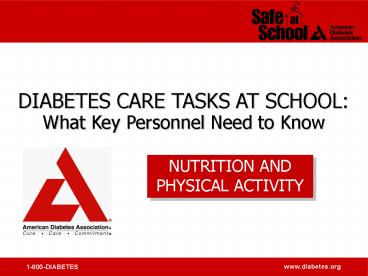NUTRITION AND PHYSICAL ACTIVITY - PowerPoint PPT Presentation
1 / 16
Title:
NUTRITION AND PHYSICAL ACTIVITY
Description:
Title: PowerPoint Presentation Author: Maren Last modified by: ADA Created Date: 1/1/1601 12:00:00 AM Document presentation format: On-screen Show Other titles – PowerPoint PPT presentation
Number of Views:51
Avg rating:3.0/5.0
Title: NUTRITION AND PHYSICAL ACTIVITY
1
NUTRITION AND PHYSICAL ACTIVITY
2
Goal Optimal Student Health and Learning
Managing nutrition and physical activity are
vital pieces of a comprehensive plan.
3
Learning Objectives
- Participants will be able to understand
- Basic meal plans for students with diabetes
- Nutrition calculation methods
- Physical activity benefits for students with
diabetes - Physical activity guidelines for students with
diabetes
4
Nutrition Why be concerned?
- Good nutrition is important for everyone for
optimal health - Nutrition planning is essential for good diabetes
control - maintain blood glucose within target range
- to prevent or delay complications
- to help children and teens grow and develop
properly - to achieve healthy weight
- promote optimal learning
5
School Nutrition Management
- Students parent/guardian and health care team
determine an individualized meal plan - A diagnosis of diabetes does NOT always limit
which foods a student can eat - Meals snacks need to be carefully timed to
balance physical activity and insulin/medications - Encourage healthy eating for all students
6
School Nutrition Management
- Students with type 2 diabetes may need additional
accommodations to help manage lipids, blood
pressure and weight
- May need support at meals and snacks to achieve
calorie level targets and consistent carb amounts - Assure that healthy foods such as whole grains,
low-fat protein and dairy, fruits, and vegetables
are available
7
Basic Meal Plans
- Key Balance insulin/medications with carb intake
- Most students have flexibility in WHAT to eat
- Basic Carbohydrate Counting
- Advanced Carbohydrate Counting
- Many students have flexibility in WHEN to eat
- More precise insulin delivery (pumps, pens)
- Rapid-acting insulins
- Time dosing of insulin according to DMMP
8
Basic Carbohydrate Counting
- Calories from
- carbohydrate
- protein
- fat
- Each nutrient type affects blood glucose
differently - Carbohydrate has the biggest effect on blood
glucose - TOTAL carbohydrate matters more than the source
(sugar or starch)
9
Advanced Carbohydrate Counting
USING THE INSULIN-TO-CARB RATIO
- The insulin-to-carb ratio
- Varies from student to student
- Is determined by the students health care team
- Should be included in the DMMP
- Usually stated as a ratio of 1 unit of insulin to
x grams carbohydrate - May vary from meal to meal for a student
10
Using Insulin-to-Carb Ratio
- Example 110 Ratio
- 1 unit of insulin to be given per 10 grams of
carbohydrate eaten - 60 gm meal / 10 gms 6 units of insulin needed
11
School Meals Snacks
- Provide school menus and nutrition information to
student/parent/guardian in advance. - Provide sufficient time for eating.
- Monitor actual food intake per DMMP
- young or newly diagnosed
- picky eaters
- Respect, encourage independence.
12
Nutrition Information at School
- The approximate carbohydrate content of school
meals can be determined in advance by the school
nutrition director and can be indicated on the
school menu for each item.
13
Beyond the Routine School Parties
- Provide parent/guardian with advance notice of
parties/special events - Follow the students DMMP, 504 Plan or IEP
- Some may prefer to bring their own foods, but may
eat what is available. - Provide nutritious party snacks or non-food
treats for all - Limit use of food as reward
14
Beyond the Routine Field Trips
- Notify school nurse as soon as trip is scheduled
to allow for consultation with parent/guardian
about food and/or insulin adjustments - Bring plenty of quick-acting sugar sources to
treat hypoglycemia - Bring lunch as appropriate
- Bring diabetes equipment and supplies, including
glucagon, if specified in DMMP - Bring list of emergency contacts, copy of
emergency care plan
15
Activity Diabetes
- Everyone benefits from physical activity.
- Students with diabetes should fully participate.
- In general, activity lowers blood glucose levels.
If there is insufficient insulin, physical
activity can raise blood glucose. - May need to make adjustments to
insulin/medications and food intake, per DMMP - A quick-acting source of glucose, glucose meter,
and water should always be available - PE teachers and coaches must be familiar with
symptoms of both high and low blood glucose
16
Activity Blood Glucose Monitoring
- Check before, during, and after physical activity
per DMMP - Especially when trying a new activity or sport
- If blood glucose starts to fall, student should
stop and have a snack or quick-acting source of
sugar - Students with pumps may disconnect or adjust the
basal rate downward temporarily, prior to
physical activity































